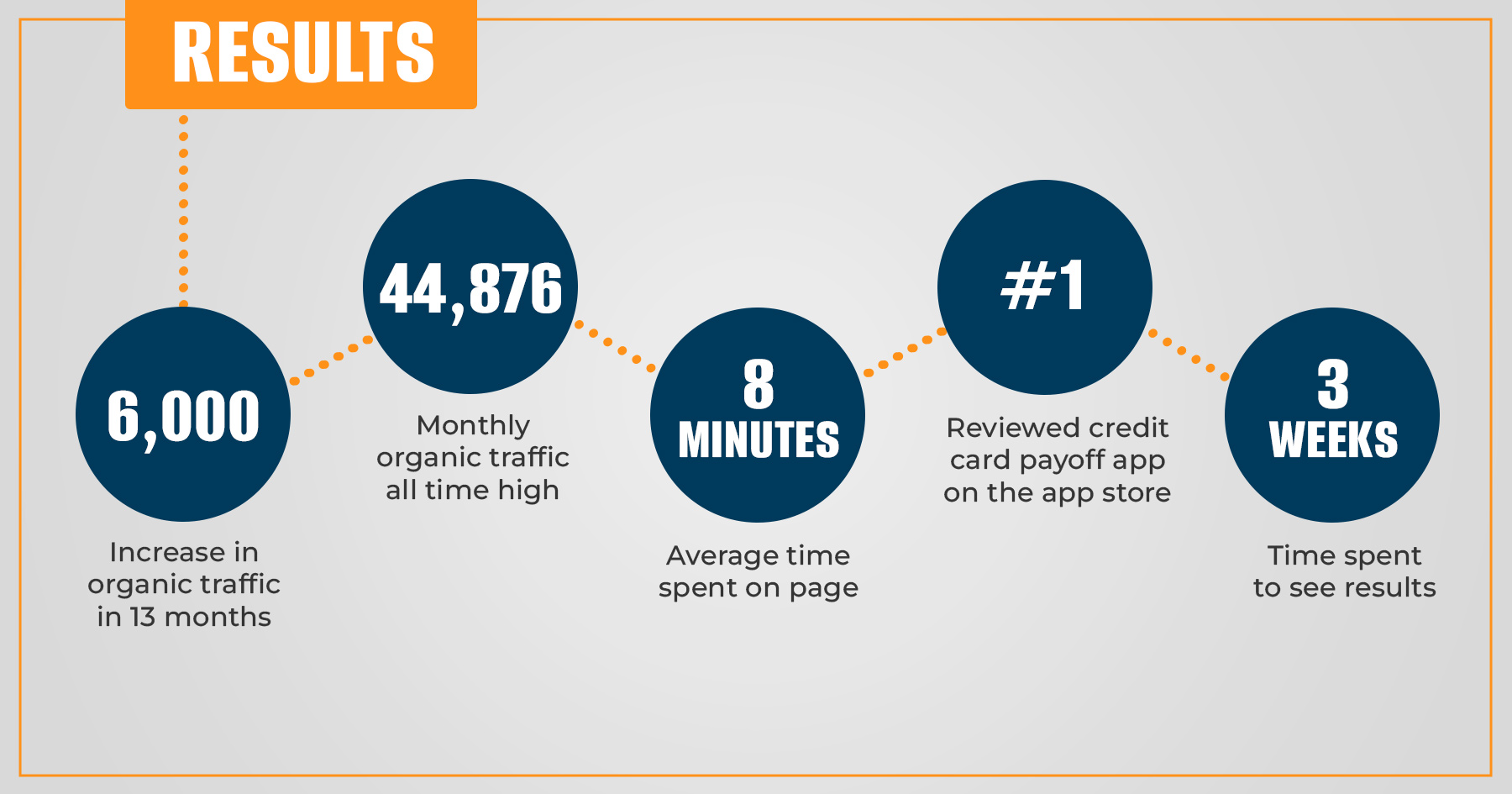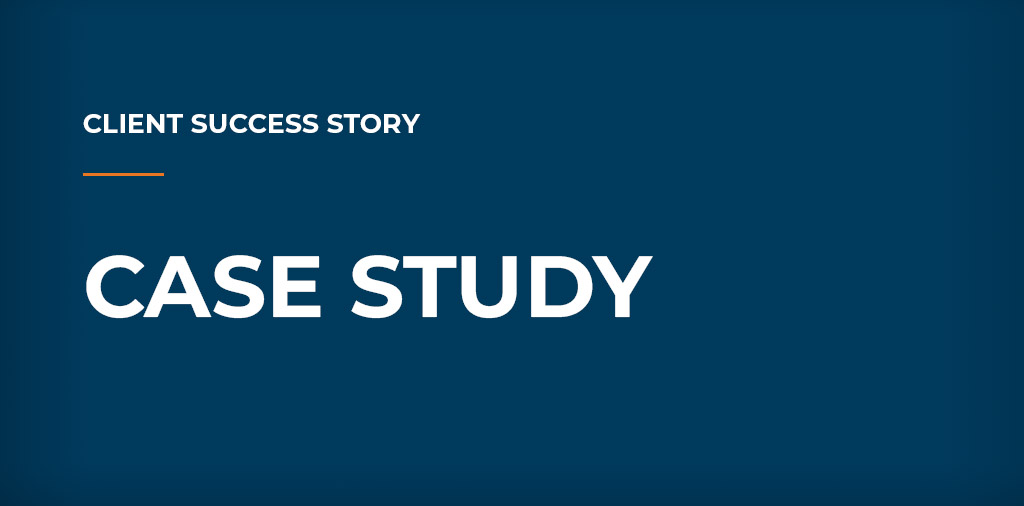The weight of consumer debt is a problem countless Americans know all too well, and one that our previous fintech client developed a solution for.
They built a personal finance app to help people take control of their finances. The app consolidated the user’s credit card debt. Then it made automated, on-time payments on their behalf — and with a lower APR.
But in such a crowded consumer debt category, the company needed more than an effective app to stand out from competitors. They also needed to establish their expertise in the fintech space.
Despite their impressive product, the brand lacked the online authority to generate enough inbound site traffic and app downloads to grow their business. After over four years in business, their blog only saw an average of 729 sessions per month.
The Business Problem: Low Traffic in a Highly Saturated Market
We first needed to have a complete understanding of the brand’s goal and challenges. This would help inform our content strategy.
Brand Goal
This brand’s goal was to use their blog as a growth tool. They wanted to:
- Establish the brand as an industry expert
- Capture the eyes of consumers who were actively searching for ways to consolidate their credit card debt
In addition, they hoped to expand their user base by positioning debt payoff as a necessary stepping stone to major life milestones, such as:
- Saving for retirement
- Taking a long-awaited family trip
- Paying off student loans
- Creating a more secure financial future
Key Challenges
With that purpose in mind, they faced two key challenges:
- Low blog traffic: The brand was seeing minimal inbound traffic to their blog. Sessions hovered around 180 per week — rarely (if ever) crossing the four-digit threshold for monthly visitors.
- Saturated market: Typing “credit card debt” into Google returned 334 million results. That made it difficult for a relatively new company to break through onto the first page of Google against well-known content competitors like NerdWallet and SoFi. The brand was competing for Google real estate that was occupied by news publications, credit card companies, and personal finance sites that existed long before the app’s initial launch.
The Strategy: Grow Traffic and Leverage the Blog as a Sales Funnel
With the brand’s goals and challenges in mind, we created a strategy to transform their challenges into growth.
The First Phase
The first step was to increase the brand’s site traffic as quickly as possible.
Why? This would allow them to finally compete for online attention in a saturated market, build trust, and increase brand awareness.
To quickly drive relevant organic traffic, we crafted a content plan that targeted low-difficulty, high-volume keywords.
The Second Phase
As organic traffic grew, we shifted to a funnel approach, filled content gaps, and slowly increased the publishing cadence. Here’s a closer look at this three-point strategy.
1. Selected Keywords With the Funnel Approach
We used a two-pronged keyword research strategy to strike a balance between:
- High-volume but moderate- to high-difficulty keywords surrounding broader financial terminology
- Long-tail, lower-volume keywords that came with less search volume but more targeted search intent
We then organized the keywords into two sales funnel buckets, assigning the appropriate calls to action based on funnel level:
- Top-of-funnel: These were broader, short-tail keywords related to anything personal finance and positioned the brand as an industry expert. For example, we’d create content about beginner investment strategies, which was a relevant topic but not one directly related to debt payoff.
- Bottom-of-funnel: These were long-tail queries that positioned debt payoff as a necessary step within a number of financial topic areas. For example, it’s nearly impossible to save for retirement until debt is paid off, and you’ll get approved for a larger mortgage with zero credit card debt.
The top-of-funnel articles were used to drive traffic and build brand trust. The hyper-targeted bottom-of-funnel articles were meant to convert readers into customers.
2. Created Solutions-Focused Articles That Filled Content Gaps
The brand needed to further break through in a highly saturated market. So we looked for opportunities to fill gaps where competitors hadn’t (yet) published content online. This meant:
- Targeting out-of-the-box keyword phrases
- Anticipating related topics a potential user might type into Google
That led us to create solutions-focused articles about various personal finance topics, including:
- Budgeting methods
- Planning for retirement
- Negotiating credit card fees
- Building credit post-bankruptcy
3. Slowly Increased the Amount of Content Published
To help drive traffic for the first 13 months, we implemented a moderate publishing cadence of 8 articles per month. Initially, this was highly effective. The blog hit an all-time high for inbound, organic traffic. But then, it hit a plateau.
To break through the stalemate, we pivoted to a gradual increase in publishing cadence. We started by doubling the amount of content published. Then we gradually increased to 20, 25, and finally 30 posts per month over the course of the next year.
The Results: Blog Grows Over 6,000% in 13 months

The strategy saw immediate results and paid dividends.
A mere 3 weeks into launching their content strategy with us — the brand’s blog hit 1,284 organic sessions, an all-time high at that point for the company.
Exactly a year into our partnership — their blog hit an all-time high of 44,876 monthly organic sessions. That was an increase of 6,055.8% over their previous year’s volume of 729 sessions.
Two years into working with us, the brand’s blog consistently saw traffic in the mid-20,000-30,000+ range.
While the increase in monthly traffic was impressive, we also achieved their goal of increasing their monthly users. In addition, they became a trusted brand within the personal finance space. This was demonstrated by their increased “average time on page” metric and their number of #1 Google rankings:
- Average time on page: The average time on page for their blog was incredibly high, with most visitors spending more than 8 minutes reading each piece, compared to an average time of 2 minutes at the start of the project. This proves readers thoroughly enjoyed reading (and learning from) the content.
- #1 Google rankings: The brand’s blog ranked #1 on Google for 251 organic keywords. This shows the brand was able to break through the stiff competition within the credit card payoff space.
What Could Your Business Accomplish With 44,000+ Monthly Visitors?
Our client was able to attract tens of thousands of prospective customers through:
- A two-pronged keyword strategy
- Solutions-oriented personal finance articles
- Consistent publishing
Our SEO strategists could help the company achieve success because they understood the brand’s challenges in a heavily saturated market.
If you’d like to see how MBE Group can implement a one-of-a-kind strategy to help increase inbound traffic and transform your blog, newsroom, or resource library into a sales tool, schedule a chat with our team today.
